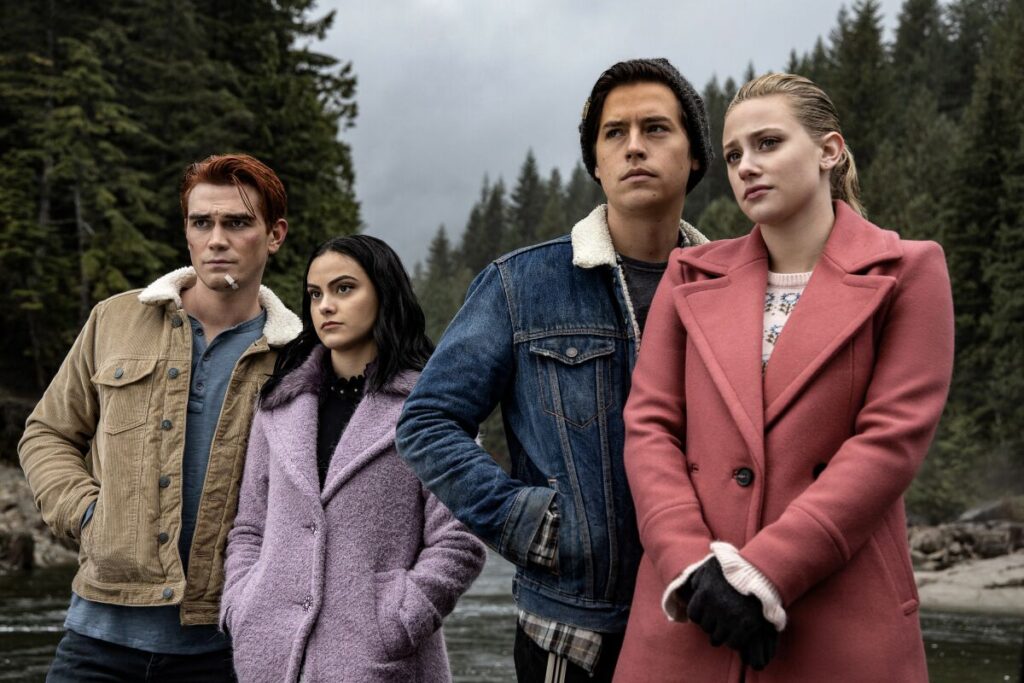When I was in seventh grade, Riverdale was in vogue.
I was not the type of middle schooler who followed the latest trends. My knowledge of the internet ended abruptly at the cushioned confines of Pinterest and I scoffed at the mention of a meme, so I learned about Riverdale through the coils of the grapevine.
It was a slumber party, and the other girls and I clustered atop a patchwork of sleeping bags in my friend’s basement. It was the last slumber party I would be invited to, although I didn’t know that yet — a fact which had something to do, I presume, with the way I clamped my hands over my eyes each time a couple made out onscreen. We’d just finished Mean Girls, and now the other girls hunched over the remote trying to decide what to watch.
The cursor hovered over an image of two figures kissing in the back seat of an inexplicably steamy Volkswagen. “RIVERDALE!” proclaimed crackling neon letters. A murmur of excitement rippled through the group.
“What?” I whipped my head around blindly. “What’s that?”
“It’s really popular,” another girl informed me. She had braces and an air of experience. “It’s like, you know the Archie comics? But it’s really edgy. And a guy gets murdered by his own dad.”
“Shhhh!” A pillow whizzed past my face. “No spoilers!”
“We should watch it.”
“Start from the beginning!”
I can’t say I was exactly transfixed. I spent most of the following 30 minutes pacing in front of the TV and pointing out all the anachronisms to a growing chorus of groans. Most of my companions lusted over Jughead; I loudly lamented the beanie that replaced his trademark paper crown. But even though I might deny it, there was something about the show that intrigued me long after the flatscreen flickered off. There was something intoxicating about this blue-tinted, cinematic Riverdale, about teenagers who skipped class to throw wild parties and plot insurance fraud in janitor’s closets. As outlandish as it appeared, my friends and I really believed there was some truth buried beneath the murders and love affairs. We whispered ourselves to sleep, gangly limbs folded in the sweat-sticky fleece of our bedrolls, and convinced ourselves that high school would resemble the picture on TV.
As the seasons dragged on, I vicariously kept tabs on Riverdale’s snarled plot through my classmates’ commentary. I had access to Netflix. The little thumbnail of that fogged-up Volkswagen beamed up at me from the Top Ten each time I opened the site — and yet for some reason, I couldn’t bring myself to watch it. High school was impending, that malevolent omen of adulthood that seemed to cling to the horizon, and the nearer it drew the more desperate I became. Some strange dread gnawed at my insides. I couldn’t watch movies, I couldn’t read novels. The mere sight of a YA romance filled me with festering anxiety. I knew I was running out of time — but for what?
The summer before eighth grade, my friend Zadie invited me to go see a movie with her, aptly named Eighth Grade. I had always dreaded theaters. The smell of popcorn and the air of expectation made me nauseous. Friends were more important than phobias, however, so I shuffled in anyway alongside matinee crowds. The instant the credits opened, I began to regret my decision.
Eighth Grade was about a kid in the same position as myself. She too was scared to enter high school. She too was ungainly and anxious and lonely. She too had delusions of grandeur. Panic lodged itself in my throat.
Always quick-witted, I devised the perfect scheme to endure that wretched movie. Each time my breath started to catch in my chest I would leap up, squeeze my way past the five other people in the aisle over a whispered river of “sorry, sorry, sorry,” and hurry out to the bathroom in the lobby. “You’re okay,” I would whisper to myself, fixing my eyes on the soapy specks of the stall door. “You’re fine.” I repeated this process at least five times, ignoring the growing distaste of my neighbors’ disgruntled glares, before the house lights graciously flickered on.
That day revealed the germ behind my strange illness. Adolescence terrified me because I knew I fell unforgivably short of its expectations. I didn’t see anything of myself reflected in the rebellious outcasts in teen dramas or the stalwart heroes of fantasy novels. I was more similar to this pathetic, sniveling Bo Burnham creation than I was to any protagonist of the books I once adored. Each new episode of Riverdale was a testament to my own failures, another empty box on the checklist of Mandatory Teenage Experiences. Soon, I would surely find myself thrust into the world of hard drugs and love triangles, and I would be eaten alive.
Adolescence washed across me slowly. It was not a ray of celestial light or a sudden epiphany, but more a logic assembled day after day — the “golden years of youth” that adults raved about had never existed, and they never would exist. Youth was mangled through the glow of the TV screen. Averageness wasn’t a cardinal sin. Riverdale bobbed into my field of vision again, but there was one crucial difference: now it was a laughingstock, not an aspiration. The poor writers, probably chained to their computers somewhere in the CW dungeon, churned out subplots about haunted asylums, speakeasies, incest, electroshock conversion. Teens collectively ridiculed the absurdity of a show they once treated as gospel, the source for gems such as: “I’m weird. I’m a weirdo. I don’t fit in. I don’t want to fit in,” or “I’m coo-coo bananas for you, obvi.” In one episode, Archie (the popular athlete with a secret soft side) has been sent to juvie, and now he persuades fellow delinquents to join his gang. “If we weren’t here, we’d be in high school,” he argues, “joining clubs, trying out for sports.”
“Not me,” growls a greaser with the body of a 30-year-old bodybuilder. “I dropped out in the fourth grade to run drugs to support my Nana.”
Archie steps forward, his eyes blazing with inspirational fervor. “Then that means you haven’t known the triumphs and defeats, the epic highs and lows of high school football.”
This scene is tone-deaf to the point of hilarity, but it illuminates how adult writers perceive their young subjects. The American imagination paints teens as universally shallow, only able to measure real-life tragedy through superficial metrics. How was it that there was such a gaping rift between media and reality? More importantly, how could so many preteens accept this show as a relevant portrayal of teen life? The answer lies in the core of teen media itself.
America is a country of ideals. Our students slog through mandatory essays on the “American Dream.” Our national anthem sings of morals and standards we have never upheld. We have a reputation for romanticizing things we shouldn’t — war, politics, the “good old days” — and once we see a concept through rose-tinted glasses we can never fully scrub that pink hue away. The teenage dream emerged in the ‘50s. Postwar America boomed in prosperity (for some) and birth rate (for all), and the insurgence of young blood coursed through verdigrised veins. Throughout the ’60s and ’70s, teens carved out their place as a force of their own. A period once scorned as awkward and purgatorial was now glorified as “the best years of your life.” Teen media cemented itself as a true genre in the 1980s, sporting stock characters like the cheerleader, jock, and nerd that would be parroted for decades to come. The dominant American ideal of independence and youthful freedom have saturated the nation’s collective consciousness. Since then, this ideal has overtaken teenage media. Stories celebrate a life free of responsibility or inhibition, a last hurrah before the monotony of adulthood.
Therein emerges the problem — the typical teen melodrama is not made for actual teens. By the 21st century, the genre is so thoroughly steeped in idealism that it becomes unrecognizable. Shows like Euphoria, Pretty Little Liars or Riverdale don’t hinge on the reality of any American teenage experience, but instead on an identity forged through years of revision. Many teens struggle with isolation, but our cinematic counterparts attend parties every night. Most modern teens grapple with intense anxiety over current issues, yet TV paints adolescents as frivolous creatures with no greater concerns than what to wear to the next dance. These characters don’t exist as mirrors for the teenage population, surfaces on which we can see our own faces transposed. Instead, they are a window to either the viewer’s past or their future.
For adults, teen dramas provide a source of nostalgia for memories they never lived. Very few people see the “teenage dream” come to fruition. Most exit their teenage years newly reeling with freedom, responsibility and a nagging sense of disappointment that will only grow as time goes on. The glamorized teens in melodramas form a surrogate through which adults can relive their teenage years on their own terms, reforming their malleable memories to fit their expectations. Adults are, of course, the primary creators of teenage television. It is adults who type the scripts, adults who select the costumes, adults who cake their faces with makeup to mimic youth before the cameras. It is adults who orchestrate hours worth of gratuitous underage sex scenes. The scenarios that unfold onscreen represent adult fantasies, not teenage dreams.
Preteens similar to my own seventh grade self look to teenage melodramas as a road map for their future. They scavenge the glitter-drenched sets of Euphoria for knowledge for the years ahead, learn about social dynamics from Gossip Girl. Despite the obvious sensationalism, these consumers on the cusp of adolescence can believe that there is some truth buried beneath these shows’ theatrical trappings. Melodrama slowly morphs into realism. This propagandized teenage dream surrounds kids at every turn: from adults’ exaggerated recollections of their own youth to the carefully curated social media accounts of their peers, idealism is inescapable.
Of course, the unrealistic expectations of modern American media inflict palpable damage on real teens. Middle schoolers feel pressured to sexualize themselves on the internet for adult validation, indoctrinated by the depiction of fictional minors. Society punishes teenagers for diverging from an invented norm. It’s not uncommon to hear teens lament that “we’re so boring.” Because the only representation of teenage life is sensationalized, average existence seems bland by comparison.
I know that I myself often feel a burning desperation over my own inadequate life. I fail to perform the role I’ve been assigned. There are times when I slip back into that middle school gaze, chastising myself for the foolish decisions I have failed to make. In spite of this, American youth must disentangle ourselves from the expectations of the media. There is no one teen experience. There is no golden ratio to craft the unregrettable adolescence. There is more to life than just the epic highs and lows of high school football.
Photo: (Jack Rowand / The CW)





Randomly came across this but was touched by the honesty of it and it really connected with my own experience. Thanks for writing it!